Analysis of Micro and Macro Factors Affecting Global Business, Tesco
VerifiedAdded on 2020/12/30
|12
|3841
|83
Report
AI Summary
This report delves into the micro and macro environmental factors that significantly influence modern business operations in the global landscape. It explores how these factors, including customers, competitors, suppliers, political and legal landscapes, technological advancements, and cultural nuances, shape the strategies and decision-making processes of international companies. The report then examines the organizational responsibility, sustainability, and ethical considerations that businesses must manage across cultural, social, environmental, and economic dimensions. The second part of the report presents a detailed case study on Tesco, a leading global retailer, analyzing its vision, leadership styles (including autocratic and democratic approaches), and management practices. The analysis highlights the implications of these techniques for Tesco's success, including strategies for employee engagement, team building, and aligning organizational goals. Finally, the report provides recommendations and strategies for businesses to adapt to the ever-changing global environment, emphasizing the importance of adapting to diverse market conditions.
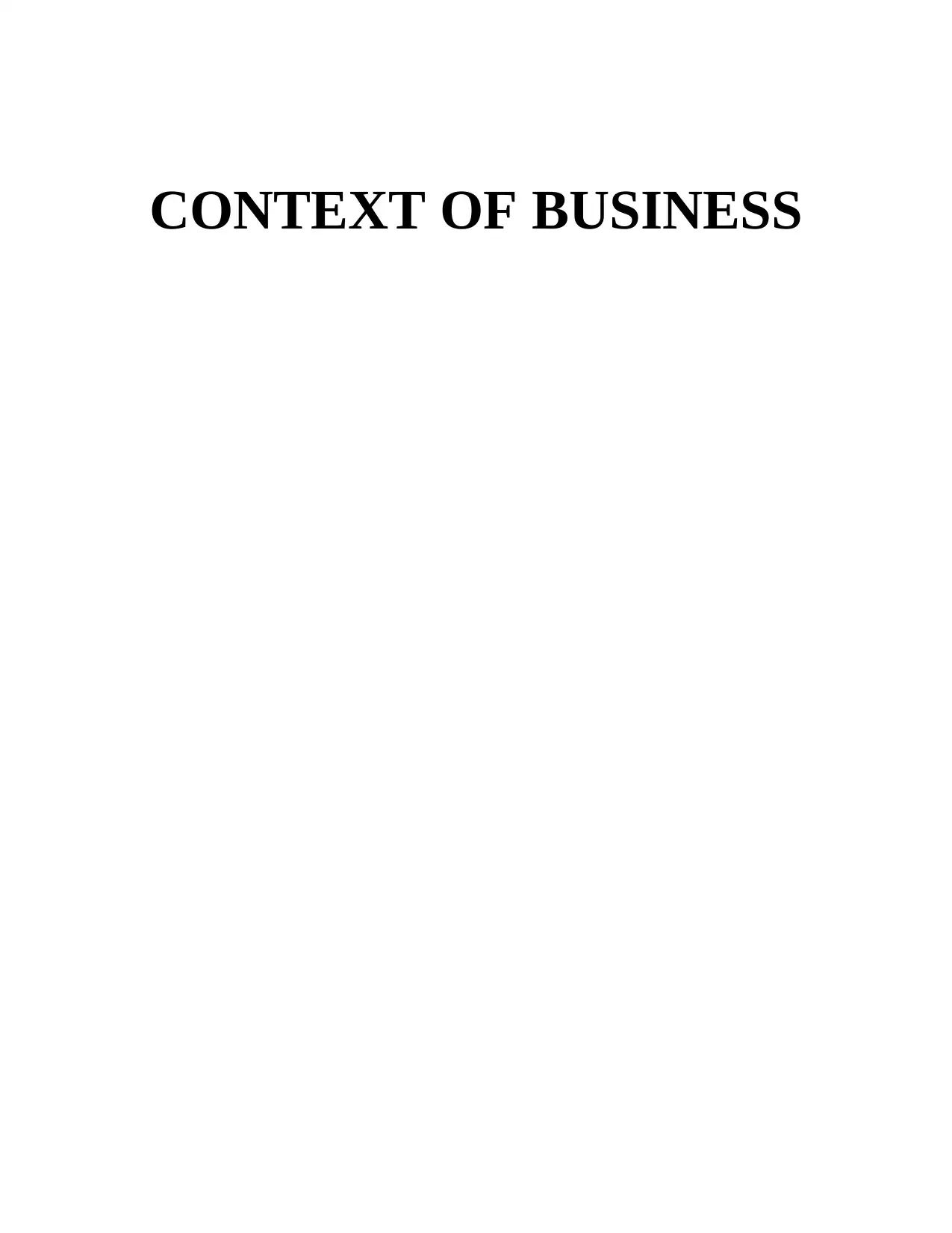
CONTEXT OF BUSINESS
Paraphrase This Document
Need a fresh take? Get an instant paraphrase of this document with our AI Paraphraser
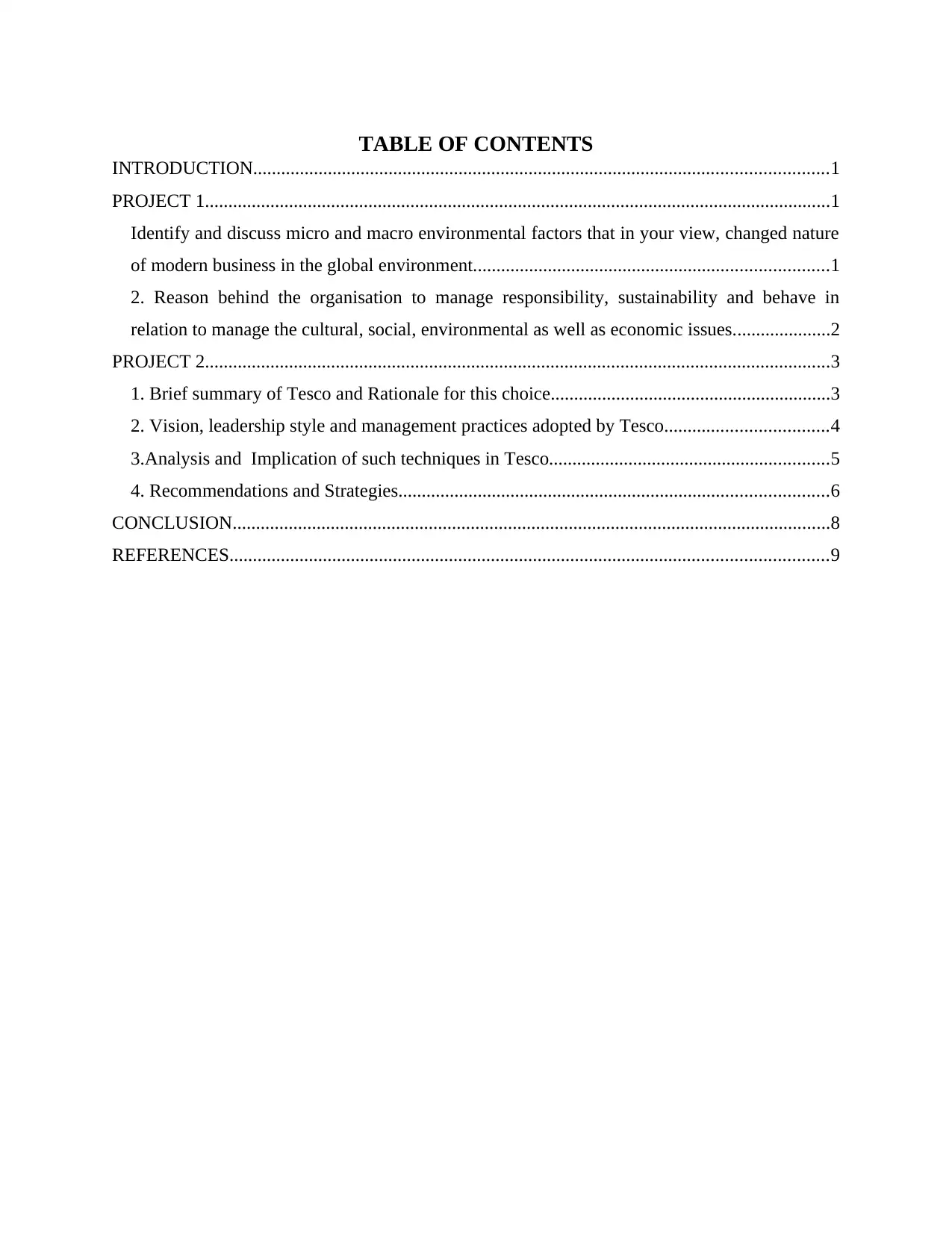
TABLE OF CONTENTS
INTRODUCTION...........................................................................................................................1
PROJECT 1......................................................................................................................................1
Identify and discuss micro and macro environmental factors that in your view, changed nature
of modern business in the global environment............................................................................1
2. Reason behind the organisation to manage responsibility, sustainability and behave in
relation to manage the cultural, social, environmental as well as economic issues.....................2
PROJECT 2......................................................................................................................................3
1. Brief summary of Tesco and Rationale for this choice............................................................3
2. Vision, leadership style and management practices adopted by Tesco...................................4
3.Analysis and Implication of such techniques in Tesco............................................................5
4. Recommendations and Strategies............................................................................................6
CONCLUSION................................................................................................................................8
REFERENCES................................................................................................................................9
INTRODUCTION...........................................................................................................................1
PROJECT 1......................................................................................................................................1
Identify and discuss micro and macro environmental factors that in your view, changed nature
of modern business in the global environment............................................................................1
2. Reason behind the organisation to manage responsibility, sustainability and behave in
relation to manage the cultural, social, environmental as well as economic issues.....................2
PROJECT 2......................................................................................................................................3
1. Brief summary of Tesco and Rationale for this choice............................................................3
2. Vision, leadership style and management practices adopted by Tesco...................................4
3.Analysis and Implication of such techniques in Tesco............................................................5
4. Recommendations and Strategies............................................................................................6
CONCLUSION................................................................................................................................8
REFERENCES................................................................................................................................9

INTRODUCTION
PROJECT 1
Identify and discuss micro and macro environmental factors that in your view, changed nature of
modern business in the global environment.
Micro environmental factors:
Micro environmental factors are those that directly effects the business operations of the
company (Anastassiu and et.al., 2016). These factors also have influence over the performance and
decision making function of the firm. It includes customers, competitors, suppliers, etc.
The business need to change its operations as per the changes occur in these factors. For
example, In case, the taste and preference of the consumer gets change, the firm needs to
change its business operations accordingly. As, avoidance of this change may result in losing the
potential customers of the company (Phillips-Wren and et.al., 2015). Further, being a global
organisation, as the company have huge amount of customers, the change in the business as per
the taste of the business may result in changing the overall nature of the company.
Further, a global business have competitors worldwide. Development of competitive
strategies as per the competitors may lead in changing the overall business operations of the
company, through which the overall business structure of the firm may gets affected.
Suppliers in the worldwide also have influence over the company's business. They effect
the cost of production and business operations of the firm (Lankoski, 2016). Development and
Implementation of strategies as per the needs price of suppliers can affect the business operations
of the company.
Macro environmental factors
These are the factors of external environment of the business. A company is indirectly
affected by these factors. They also influence the various business operations of the company
and its decision making functions as well (Wirtz and et.al., 2016). Many factors like political
factors, legal factors, technological factors, etc. can be included in the macro environmental
factors.
As business of a global company spreads worldwide, these factors have major influence
over the business operations of a company. For example, a global company needs to make
frequent research over the technological updation at worldwide level. In present time, a company
need to update itself as per the technological changes in the market, as using outdated technology
1
PROJECT 1
Identify and discuss micro and macro environmental factors that in your view, changed nature of
modern business in the global environment.
Micro environmental factors:
Micro environmental factors are those that directly effects the business operations of the
company (Anastassiu and et.al., 2016). These factors also have influence over the performance and
decision making function of the firm. It includes customers, competitors, suppliers, etc.
The business need to change its operations as per the changes occur in these factors. For
example, In case, the taste and preference of the consumer gets change, the firm needs to
change its business operations accordingly. As, avoidance of this change may result in losing the
potential customers of the company (Phillips-Wren and et.al., 2015). Further, being a global
organisation, as the company have huge amount of customers, the change in the business as per
the taste of the business may result in changing the overall nature of the company.
Further, a global business have competitors worldwide. Development of competitive
strategies as per the competitors may lead in changing the overall business operations of the
company, through which the overall business structure of the firm may gets affected.
Suppliers in the worldwide also have influence over the company's business. They effect
the cost of production and business operations of the firm (Lankoski, 2016). Development and
Implementation of strategies as per the needs price of suppliers can affect the business operations
of the company.
Macro environmental factors
These are the factors of external environment of the business. A company is indirectly
affected by these factors. They also influence the various business operations of the company
and its decision making functions as well (Wirtz and et.al., 2016). Many factors like political
factors, legal factors, technological factors, etc. can be included in the macro environmental
factors.
As business of a global company spreads worldwide, these factors have major influence
over the business operations of a company. For example, a global company needs to make
frequent research over the technological updation at worldwide level. In present time, a company
need to update itself as per the technological changes in the market, as using outdated technology
1
⊘ This is a preview!⊘
Do you want full access?
Subscribe today to unlock all pages.

Trusted by 1+ million students worldwide
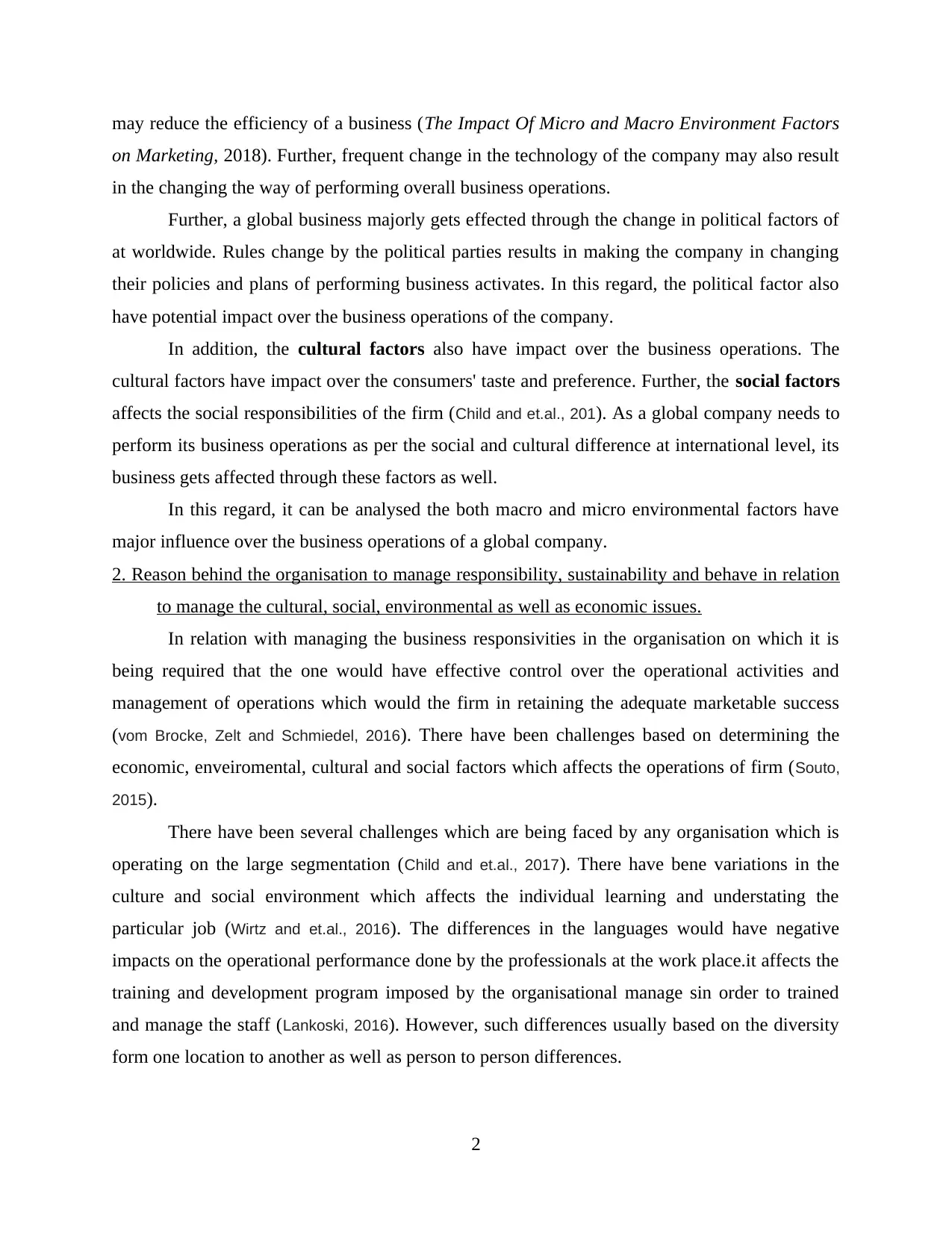
may reduce the efficiency of a business (The Impact Of Micro and Macro Environment Factors
on Marketing, 2018). Further, frequent change in the technology of the company may also result
in the changing the way of performing overall business operations.
Further, a global business majorly gets effected through the change in political factors of
at worldwide. Rules change by the political parties results in making the company in changing
their policies and plans of performing business activates. In this regard, the political factor also
have potential impact over the business operations of the company.
In addition, the cultural factors also have impact over the business operations. The
cultural factors have impact over the consumers' taste and preference. Further, the social factors
affects the social responsibilities of the firm (Child and et.al., 201). As a global company needs to
perform its business operations as per the social and cultural difference at international level, its
business gets affected through these factors as well.
In this regard, it can be analysed the both macro and micro environmental factors have
major influence over the business operations of a global company.
2. Reason behind the organisation to manage responsibility, sustainability and behave in relation
to manage the cultural, social, environmental as well as economic issues.
In relation with managing the business responsivities in the organisation on which it is
being required that the one would have effective control over the operational activities and
management of operations which would the firm in retaining the adequate marketable success
(vom Brocke, Zelt and Schmiedel, 2016). There have been challenges based on determining the
economic, enveiromental, cultural and social factors which affects the operations of firm (Souto,
2015).
There have been several challenges which are being faced by any organisation which is
operating on the large segmentation (Child and et.al., 2017). There have bene variations in the
culture and social environment which affects the individual learning and understating the
particular job (Wirtz and et.al., 2016). The differences in the languages would have negative
impacts on the operational performance done by the professionals at the work place.it affects the
training and development program imposed by the organisational manage sin order to trained
and manage the staff (Lankoski, 2016). However, such differences usually based on the diversity
form one location to another as well as person to person differences.
2
on Marketing, 2018). Further, frequent change in the technology of the company may also result
in the changing the way of performing overall business operations.
Further, a global business majorly gets effected through the change in political factors of
at worldwide. Rules change by the political parties results in making the company in changing
their policies and plans of performing business activates. In this regard, the political factor also
have potential impact over the business operations of the company.
In addition, the cultural factors also have impact over the business operations. The
cultural factors have impact over the consumers' taste and preference. Further, the social factors
affects the social responsibilities of the firm (Child and et.al., 201). As a global company needs to
perform its business operations as per the social and cultural difference at international level, its
business gets affected through these factors as well.
In this regard, it can be analysed the both macro and micro environmental factors have
major influence over the business operations of a global company.
2. Reason behind the organisation to manage responsibility, sustainability and behave in relation
to manage the cultural, social, environmental as well as economic issues.
In relation with managing the business responsivities in the organisation on which it is
being required that the one would have effective control over the operational activities and
management of operations which would the firm in retaining the adequate marketable success
(vom Brocke, Zelt and Schmiedel, 2016). There have been challenges based on determining the
economic, enveiromental, cultural and social factors which affects the operations of firm (Souto,
2015).
There have been several challenges which are being faced by any organisation which is
operating on the large segmentation (Child and et.al., 2017). There have bene variations in the
culture and social environment which affects the individual learning and understating the
particular job (Wirtz and et.al., 2016). The differences in the languages would have negative
impacts on the operational performance done by the professionals at the work place.it affects the
training and development program imposed by the organisational manage sin order to trained
and manage the staff (Lankoski, 2016). However, such differences usually based on the diversity
form one location to another as well as person to person differences.
2
Paraphrase This Document
Need a fresh take? Get an instant paraphrase of this document with our AI Paraphraser
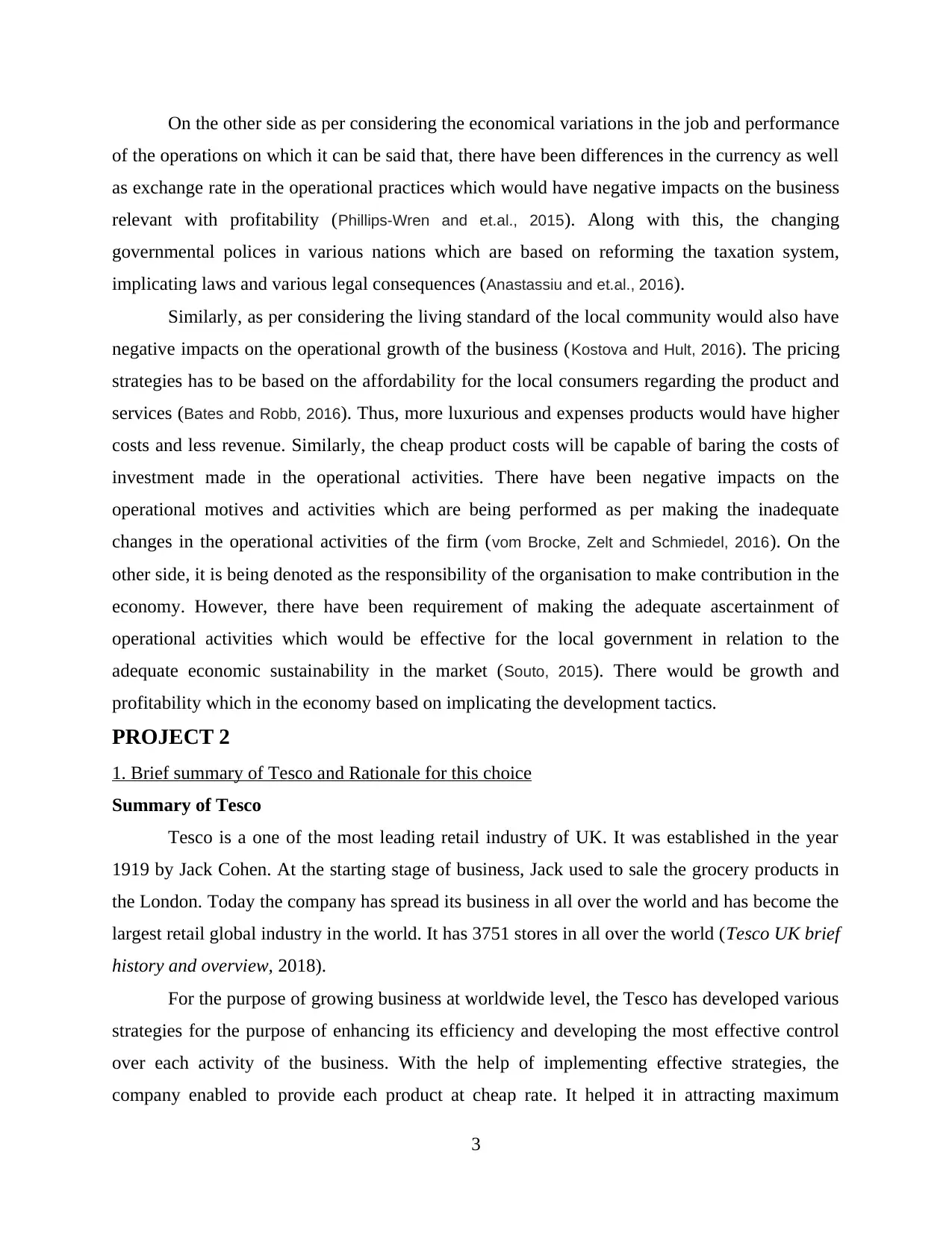
On the other side as per considering the economical variations in the job and performance
of the operations on which it can be said that, there have been differences in the currency as well
as exchange rate in the operational practices which would have negative impacts on the business
relevant with profitability (Phillips-Wren and et.al., 2015). Along with this, the changing
governmental polices in various nations which are based on reforming the taxation system,
implicating laws and various legal consequences (Anastassiu and et.al., 2016).
Similarly, as per considering the living standard of the local community would also have
negative impacts on the operational growth of the business (Kostova and Hult, 2016). The pricing
strategies has to be based on the affordability for the local consumers regarding the product and
services (Bates and Robb, 2016). Thus, more luxurious and expenses products would have higher
costs and less revenue. Similarly, the cheap product costs will be capable of baring the costs of
investment made in the operational activities. There have been negative impacts on the
operational motives and activities which are being performed as per making the inadequate
changes in the operational activities of the firm (vom Brocke, Zelt and Schmiedel, 2016). On the
other side, it is being denoted as the responsibility of the organisation to make contribution in the
economy. However, there have been requirement of making the adequate ascertainment of
operational activities which would be effective for the local government in relation to the
adequate economic sustainability in the market (Souto, 2015). There would be growth and
profitability which in the economy based on implicating the development tactics.
PROJECT 2
1. Brief summary of Tesco and Rationale for this choice
Summary of Tesco
Tesco is a one of the most leading retail industry of UK. It was established in the year
1919 by Jack Cohen. At the starting stage of business, Jack used to sale the grocery products in
the London. Today the company has spread its business in all over the world and has become the
largest retail global industry in the world. It has 3751 stores in all over the world (Tesco UK brief
history and overview, 2018).
For the purpose of growing business at worldwide level, the Tesco has developed various
strategies for the purpose of enhancing its efficiency and developing the most effective control
over each activity of the business. With the help of implementing effective strategies, the
company enabled to provide each product at cheap rate. It helped it in attracting maximum
3
of the operations on which it can be said that, there have been differences in the currency as well
as exchange rate in the operational practices which would have negative impacts on the business
relevant with profitability (Phillips-Wren and et.al., 2015). Along with this, the changing
governmental polices in various nations which are based on reforming the taxation system,
implicating laws and various legal consequences (Anastassiu and et.al., 2016).
Similarly, as per considering the living standard of the local community would also have
negative impacts on the operational growth of the business (Kostova and Hult, 2016). The pricing
strategies has to be based on the affordability for the local consumers regarding the product and
services (Bates and Robb, 2016). Thus, more luxurious and expenses products would have higher
costs and less revenue. Similarly, the cheap product costs will be capable of baring the costs of
investment made in the operational activities. There have been negative impacts on the
operational motives and activities which are being performed as per making the inadequate
changes in the operational activities of the firm (vom Brocke, Zelt and Schmiedel, 2016). On the
other side, it is being denoted as the responsibility of the organisation to make contribution in the
economy. However, there have been requirement of making the adequate ascertainment of
operational activities which would be effective for the local government in relation to the
adequate economic sustainability in the market (Souto, 2015). There would be growth and
profitability which in the economy based on implicating the development tactics.
PROJECT 2
1. Brief summary of Tesco and Rationale for this choice
Summary of Tesco
Tesco is a one of the most leading retail industry of UK. It was established in the year
1919 by Jack Cohen. At the starting stage of business, Jack used to sale the grocery products in
the London. Today the company has spread its business in all over the world and has become the
largest retail global industry in the world. It has 3751 stores in all over the world (Tesco UK brief
history and overview, 2018).
For the purpose of growing business at worldwide level, the Tesco has developed various
strategies for the purpose of enhancing its efficiency and developing the most effective control
over each activity of the business. With the help of implementing effective strategies, the
company enabled to provide each product at cheap rate. It helped it in attracting maximum
3
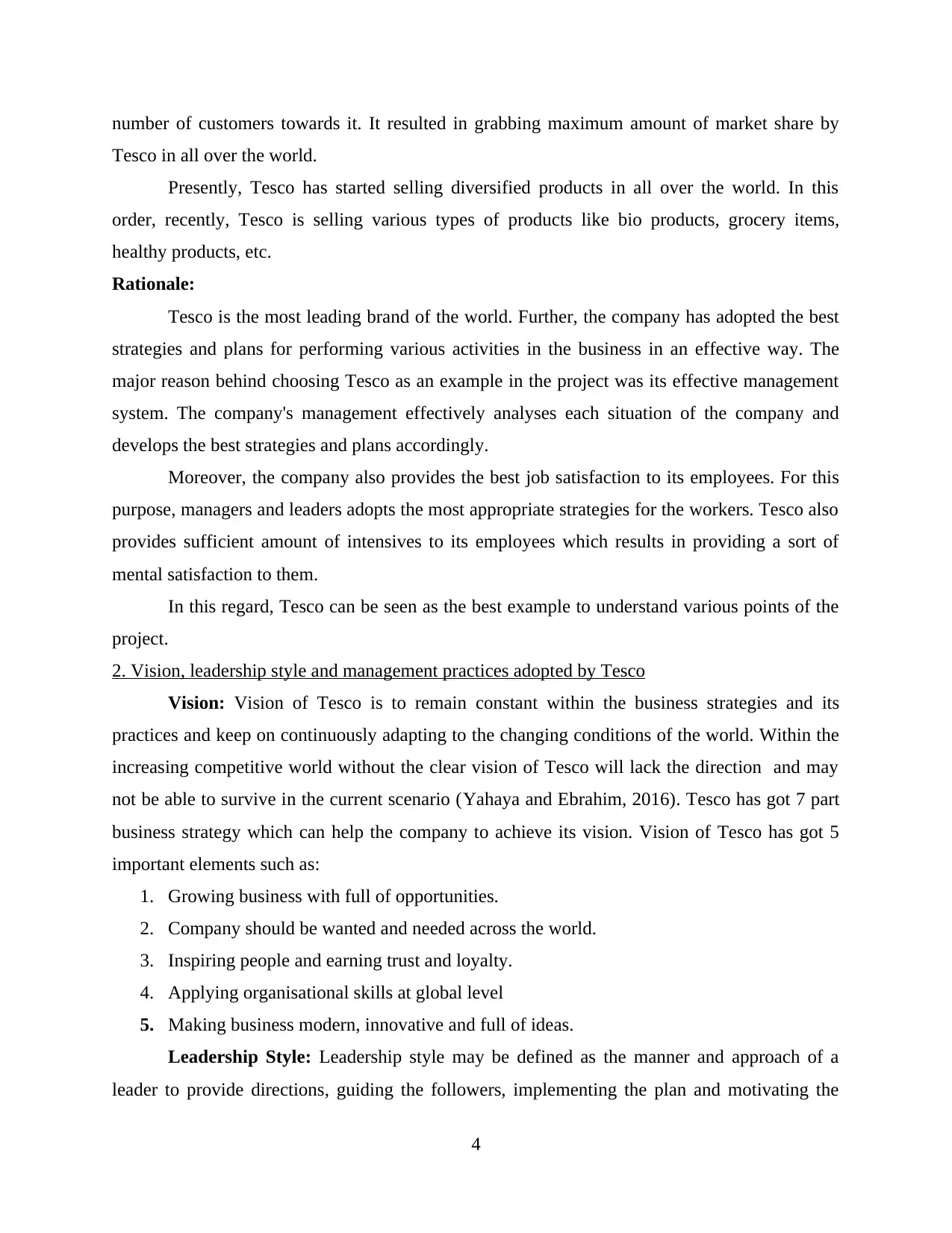
number of customers towards it. It resulted in grabbing maximum amount of market share by
Tesco in all over the world.
Presently, Tesco has started selling diversified products in all over the world. In this
order, recently, Tesco is selling various types of products like bio products, grocery items,
healthy products, etc.
Rationale:
Tesco is the most leading brand of the world. Further, the company has adopted the best
strategies and plans for performing various activities in the business in an effective way. The
major reason behind choosing Tesco as an example in the project was its effective management
system. The company's management effectively analyses each situation of the company and
develops the best strategies and plans accordingly.
Moreover, the company also provides the best job satisfaction to its employees. For this
purpose, managers and leaders adopts the most appropriate strategies for the workers. Tesco also
provides sufficient amount of intensives to its employees which results in providing a sort of
mental satisfaction to them.
In this regard, Tesco can be seen as the best example to understand various points of the
project.
2. Vision, leadership style and management practices adopted by Tesco
Vision: Vision of Tesco is to remain constant within the business strategies and its
practices and keep on continuously adapting to the changing conditions of the world. Within the
increasing competitive world without the clear vision of Tesco will lack the direction and may
not be able to survive in the current scenario (Yahaya and Ebrahim, 2016). Tesco has got 7 part
business strategy which can help the company to achieve its vision. Vision of Tesco has got 5
important elements such as:
1. Growing business with full of opportunities.
2. Company should be wanted and needed across the world.
3. Inspiring people and earning trust and loyalty.
4. Applying organisational skills at global level
5. Making business modern, innovative and full of ideas.
Leadership Style: Leadership style may be defined as the manner and approach of a
leader to provide directions, guiding the followers, implementing the plan and motivating the
4
Tesco in all over the world.
Presently, Tesco has started selling diversified products in all over the world. In this
order, recently, Tesco is selling various types of products like bio products, grocery items,
healthy products, etc.
Rationale:
Tesco is the most leading brand of the world. Further, the company has adopted the best
strategies and plans for performing various activities in the business in an effective way. The
major reason behind choosing Tesco as an example in the project was its effective management
system. The company's management effectively analyses each situation of the company and
develops the best strategies and plans accordingly.
Moreover, the company also provides the best job satisfaction to its employees. For this
purpose, managers and leaders adopts the most appropriate strategies for the workers. Tesco also
provides sufficient amount of intensives to its employees which results in providing a sort of
mental satisfaction to them.
In this regard, Tesco can be seen as the best example to understand various points of the
project.
2. Vision, leadership style and management practices adopted by Tesco
Vision: Vision of Tesco is to remain constant within the business strategies and its
practices and keep on continuously adapting to the changing conditions of the world. Within the
increasing competitive world without the clear vision of Tesco will lack the direction and may
not be able to survive in the current scenario (Yahaya and Ebrahim, 2016). Tesco has got 7 part
business strategy which can help the company to achieve its vision. Vision of Tesco has got 5
important elements such as:
1. Growing business with full of opportunities.
2. Company should be wanted and needed across the world.
3. Inspiring people and earning trust and loyalty.
4. Applying organisational skills at global level
5. Making business modern, innovative and full of ideas.
Leadership Style: Leadership style may be defined as the manner and approach of a
leader to provide directions, guiding the followers, implementing the plan and motivating the
4
⊘ This is a preview!⊘
Do you want full access?
Subscribe today to unlock all pages.

Trusted by 1+ million students worldwide
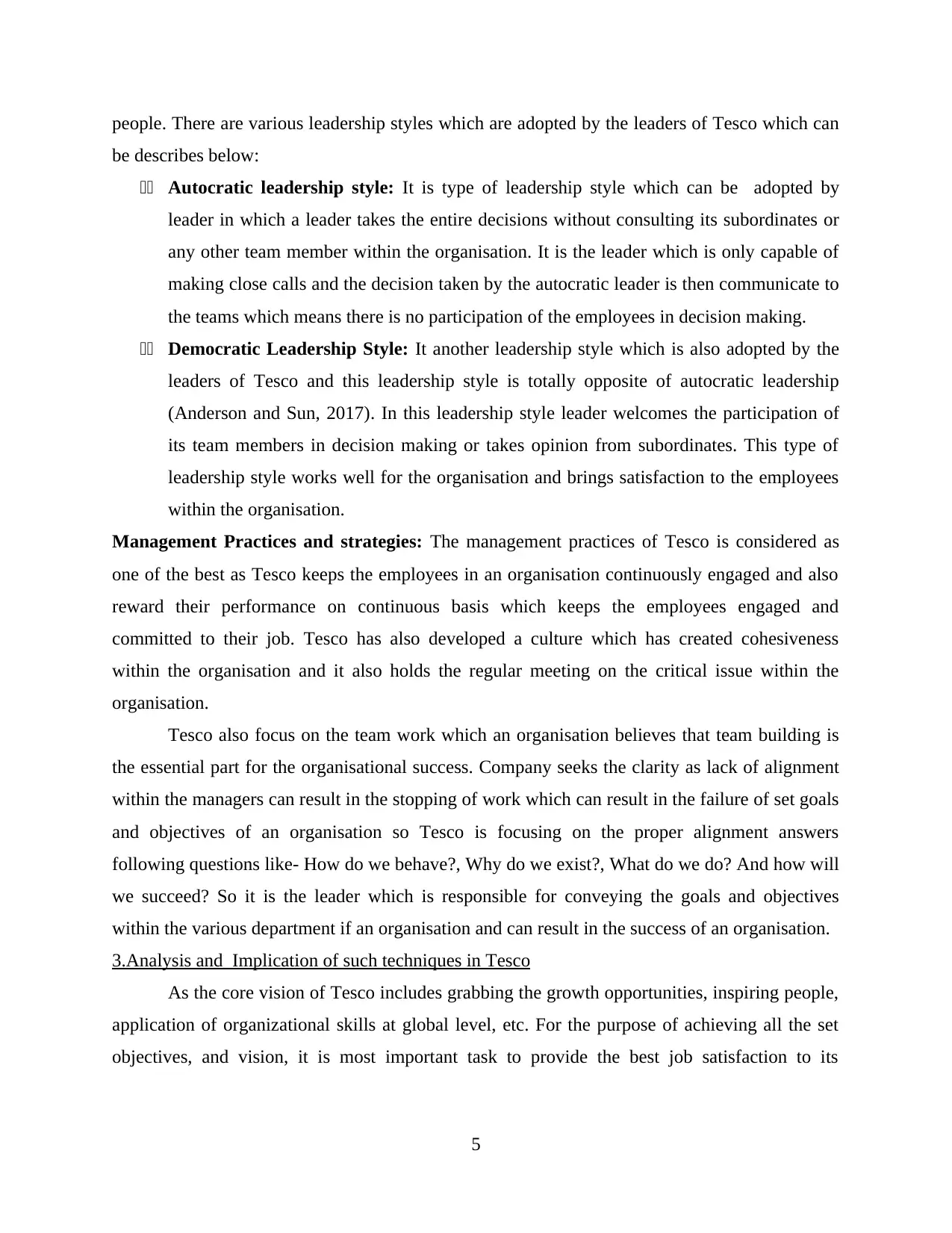
people. There are various leadership styles which are adopted by the leaders of Tesco which can
be describes below:
11 Autocratic leadership style: It is type of leadership style which can be adopted by
leader in which a leader takes the entire decisions without consulting its subordinates or
any other team member within the organisation. It is the leader which is only capable of
making close calls and the decision taken by the autocratic leader is then communicate to
the teams which means there is no participation of the employees in decision making.
11 Democratic Leadership Style: It another leadership style which is also adopted by the
leaders of Tesco and this leadership style is totally opposite of autocratic leadership
(Anderson and Sun, 2017). In this leadership style leader welcomes the participation of
its team members in decision making or takes opinion from subordinates. This type of
leadership style works well for the organisation and brings satisfaction to the employees
within the organisation.
Management Practices and strategies: The management practices of Tesco is considered as
one of the best as Tesco keeps the employees in an organisation continuously engaged and also
reward their performance on continuous basis which keeps the employees engaged and
committed to their job. Tesco has also developed a culture which has created cohesiveness
within the organisation and it also holds the regular meeting on the critical issue within the
organisation.
Tesco also focus on the team work which an organisation believes that team building is
the essential part for the organisational success. Company seeks the clarity as lack of alignment
within the managers can result in the stopping of work which can result in the failure of set goals
and objectives of an organisation so Tesco is focusing on the proper alignment answers
following questions like- How do we behave?, Why do we exist?, What do we do? And how will
we succeed? So it is the leader which is responsible for conveying the goals and objectives
within the various department if an organisation and can result in the success of an organisation.
3.Analysis and Implication of such techniques in Tesco
As the core vision of Tesco includes grabbing the growth opportunities, inspiring people,
application of organizational skills at global level, etc. For the purpose of achieving all the set
objectives, and vision, it is most important task to provide the best job satisfaction to its
5
be describes below:
11 Autocratic leadership style: It is type of leadership style which can be adopted by
leader in which a leader takes the entire decisions without consulting its subordinates or
any other team member within the organisation. It is the leader which is only capable of
making close calls and the decision taken by the autocratic leader is then communicate to
the teams which means there is no participation of the employees in decision making.
11 Democratic Leadership Style: It another leadership style which is also adopted by the
leaders of Tesco and this leadership style is totally opposite of autocratic leadership
(Anderson and Sun, 2017). In this leadership style leader welcomes the participation of
its team members in decision making or takes opinion from subordinates. This type of
leadership style works well for the organisation and brings satisfaction to the employees
within the organisation.
Management Practices and strategies: The management practices of Tesco is considered as
one of the best as Tesco keeps the employees in an organisation continuously engaged and also
reward their performance on continuous basis which keeps the employees engaged and
committed to their job. Tesco has also developed a culture which has created cohesiveness
within the organisation and it also holds the regular meeting on the critical issue within the
organisation.
Tesco also focus on the team work which an organisation believes that team building is
the essential part for the organisational success. Company seeks the clarity as lack of alignment
within the managers can result in the stopping of work which can result in the failure of set goals
and objectives of an organisation so Tesco is focusing on the proper alignment answers
following questions like- How do we behave?, Why do we exist?, What do we do? And how will
we succeed? So it is the leader which is responsible for conveying the goals and objectives
within the various department if an organisation and can result in the success of an organisation.
3.Analysis and Implication of such techniques in Tesco
As the core vision of Tesco includes grabbing the growth opportunities, inspiring people,
application of organizational skills at global level, etc. For the purpose of achieving all the set
objectives, and vision, it is most important task to provide the best job satisfaction to its
5
Paraphrase This Document
Need a fresh take? Get an instant paraphrase of this document with our AI Paraphraser

employees. As workers are the core element of business through which it can achieve its goals
(Hu and et.al., 2016).
In this order, a company needs to apply the best leadership style in all over the company.
It can help the company in providing appropriate guidance to employees through which Tesco
can enhance the ability of the employees and achieve its set objectives.
There are various leadership practices that can be used by the company for leading and
directing its employees like:
1. Autocratic leadership style: As per the above analysis, in this style the management
does not involve workers in their decision making functioning. Each decision is being
taken as per the views and perception of the managers and leaders. This style should be
used at the time of taking some major and secured decisions for the company. This style
should not be implemented in each decision making of the management. As, adoption of
autocratic leadership style can lead in reducing the involvement of workers in the
company. It may result in reducing the satisfaction level of employees in Tesco.
2. Democratic leadership style: Democratic leadership style can be analysed as an
effective style of leadership. Adoption of this leadership enhances the involvement of
employees in the Tesco. Further, it makes them feel an important part of the business
organisation which may also result in enhancing th emotional attachment of employees
with the firm (Filimonau and Gherbin, 2017). Although, this leadership style also can not
be implemented in each managerial decision making. If Tesco starts involving each
employee in its decision making, it would result in leaking various important secrets of
the business. It could be harmful for the company's business operations and growth as
well.
Managerial strategies and practices in Tesco: From the above study over Tesco's management
strategies and practices, it can be analyzed that the company has developed the best strategies for
running its daily operations and enhancing its efficiency of performance of overall business
(Bakar, Rasid and Rizal, 2016).
4. Recommendations and Strategies
The leadership of Tesco has been seen as one of the most important requirement in order
to achieve set goals and objective and ensure better growth. The leadership of the organization is
essential to motivate the employees, manage risks and set required visions. The autocratic style
6
(Hu and et.al., 2016).
In this order, a company needs to apply the best leadership style in all over the company.
It can help the company in providing appropriate guidance to employees through which Tesco
can enhance the ability of the employees and achieve its set objectives.
There are various leadership practices that can be used by the company for leading and
directing its employees like:
1. Autocratic leadership style: As per the above analysis, in this style the management
does not involve workers in their decision making functioning. Each decision is being
taken as per the views and perception of the managers and leaders. This style should be
used at the time of taking some major and secured decisions for the company. This style
should not be implemented in each decision making of the management. As, adoption of
autocratic leadership style can lead in reducing the involvement of workers in the
company. It may result in reducing the satisfaction level of employees in Tesco.
2. Democratic leadership style: Democratic leadership style can be analysed as an
effective style of leadership. Adoption of this leadership enhances the involvement of
employees in the Tesco. Further, it makes them feel an important part of the business
organisation which may also result in enhancing th emotional attachment of employees
with the firm (Filimonau and Gherbin, 2017). Although, this leadership style also can not
be implemented in each managerial decision making. If Tesco starts involving each
employee in its decision making, it would result in leaking various important secrets of
the business. It could be harmful for the company's business operations and growth as
well.
Managerial strategies and practices in Tesco: From the above study over Tesco's management
strategies and practices, it can be analyzed that the company has developed the best strategies for
running its daily operations and enhancing its efficiency of performance of overall business
(Bakar, Rasid and Rizal, 2016).
4. Recommendations and Strategies
The leadership of Tesco has been seen as one of the most important requirement in order
to achieve set goals and objective and ensure better growth. The leadership of the organization is
essential to motivate the employees, manage risks and set required visions. The autocratic style
6
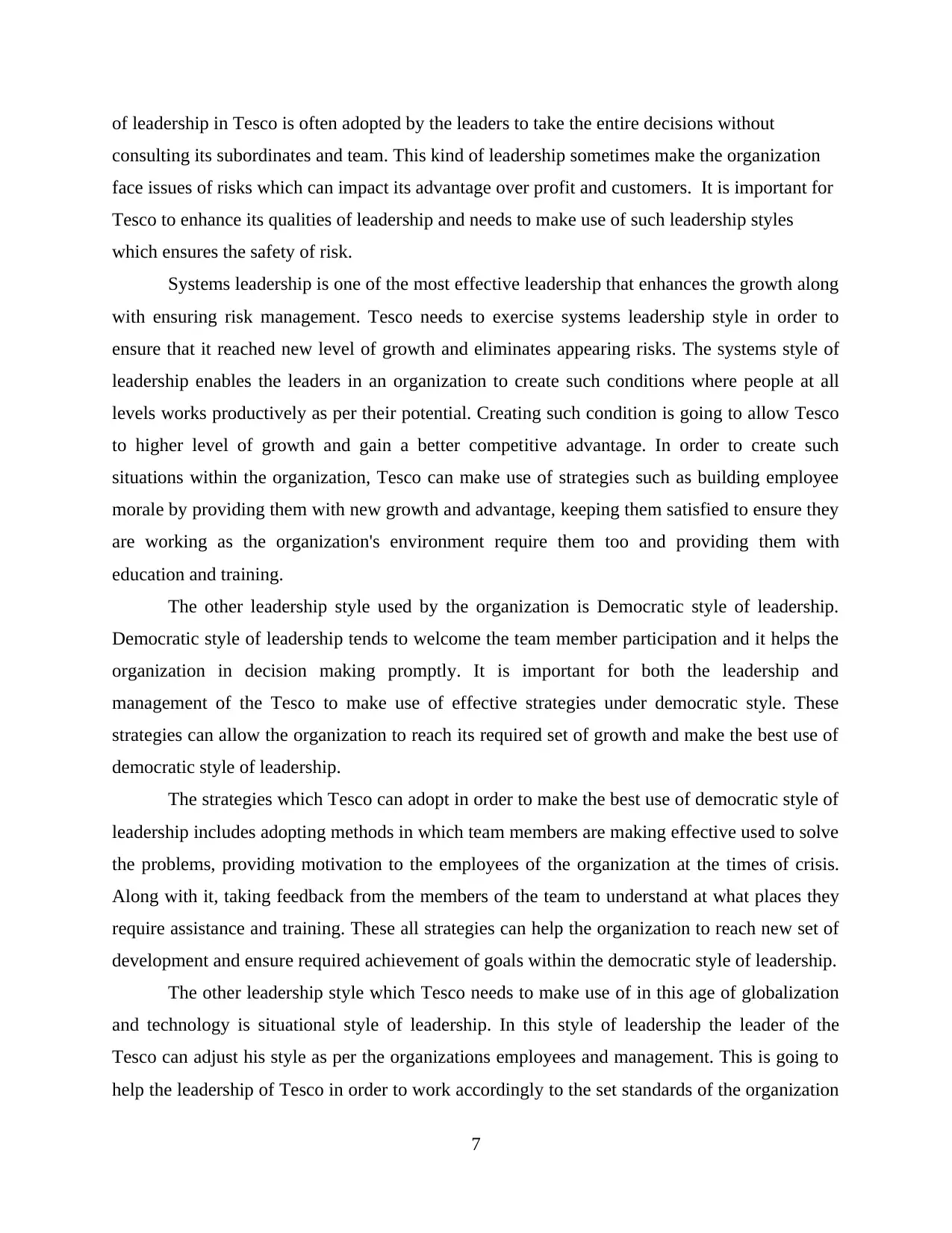
of leadership in Tesco is often adopted by the leaders to take the entire decisions without
consulting its subordinates and team. This kind of leadership sometimes make the organization
face issues of risks which can impact its advantage over profit and customers. It is important for
Tesco to enhance its qualities of leadership and needs to make use of such leadership styles
which ensures the safety of risk.
Systems leadership is one of the most effective leadership that enhances the growth along
with ensuring risk management. Tesco needs to exercise systems leadership style in order to
ensure that it reached new level of growth and eliminates appearing risks. The systems style of
leadership enables the leaders in an organization to create such conditions where people at all
levels works productively as per their potential. Creating such condition is going to allow Tesco
to higher level of growth and gain a better competitive advantage. In order to create such
situations within the organization, Tesco can make use of strategies such as building employee
morale by providing them with new growth and advantage, keeping them satisfied to ensure they
are working as the organization's environment require them too and providing them with
education and training.
The other leadership style used by the organization is Democratic style of leadership.
Democratic style of leadership tends to welcome the team member participation and it helps the
organization in decision making promptly. It is important for both the leadership and
management of the Tesco to make use of effective strategies under democratic style. These
strategies can allow the organization to reach its required set of growth and make the best use of
democratic style of leadership.
The strategies which Tesco can adopt in order to make the best use of democratic style of
leadership includes adopting methods in which team members are making effective used to solve
the problems, providing motivation to the employees of the organization at the times of crisis.
Along with it, taking feedback from the members of the team to understand at what places they
require assistance and training. These all strategies can help the organization to reach new set of
development and ensure required achievement of goals within the democratic style of leadership.
The other leadership style which Tesco needs to make use of in this age of globalization
and technology is situational style of leadership. In this style of leadership the leader of the
Tesco can adjust his style as per the organizations employees and management. This is going to
help the leadership of Tesco in order to work accordingly to the set standards of the organization
7
consulting its subordinates and team. This kind of leadership sometimes make the organization
face issues of risks which can impact its advantage over profit and customers. It is important for
Tesco to enhance its qualities of leadership and needs to make use of such leadership styles
which ensures the safety of risk.
Systems leadership is one of the most effective leadership that enhances the growth along
with ensuring risk management. Tesco needs to exercise systems leadership style in order to
ensure that it reached new level of growth and eliminates appearing risks. The systems style of
leadership enables the leaders in an organization to create such conditions where people at all
levels works productively as per their potential. Creating such condition is going to allow Tesco
to higher level of growth and gain a better competitive advantage. In order to create such
situations within the organization, Tesco can make use of strategies such as building employee
morale by providing them with new growth and advantage, keeping them satisfied to ensure they
are working as the organization's environment require them too and providing them with
education and training.
The other leadership style used by the organization is Democratic style of leadership.
Democratic style of leadership tends to welcome the team member participation and it helps the
organization in decision making promptly. It is important for both the leadership and
management of the Tesco to make use of effective strategies under democratic style. These
strategies can allow the organization to reach its required set of growth and make the best use of
democratic style of leadership.
The strategies which Tesco can adopt in order to make the best use of democratic style of
leadership includes adopting methods in which team members are making effective used to solve
the problems, providing motivation to the employees of the organization at the times of crisis.
Along with it, taking feedback from the members of the team to understand at what places they
require assistance and training. These all strategies can help the organization to reach new set of
development and ensure required achievement of goals within the democratic style of leadership.
The other leadership style which Tesco needs to make use of in this age of globalization
and technology is situational style of leadership. In this style of leadership the leader of the
Tesco can adjust his style as per the organizations employees and management. This is going to
help the leadership of Tesco in order to work accordingly to the set standards of the organization
7
⊘ This is a preview!⊘
Do you want full access?
Subscribe today to unlock all pages.

Trusted by 1+ million students worldwide
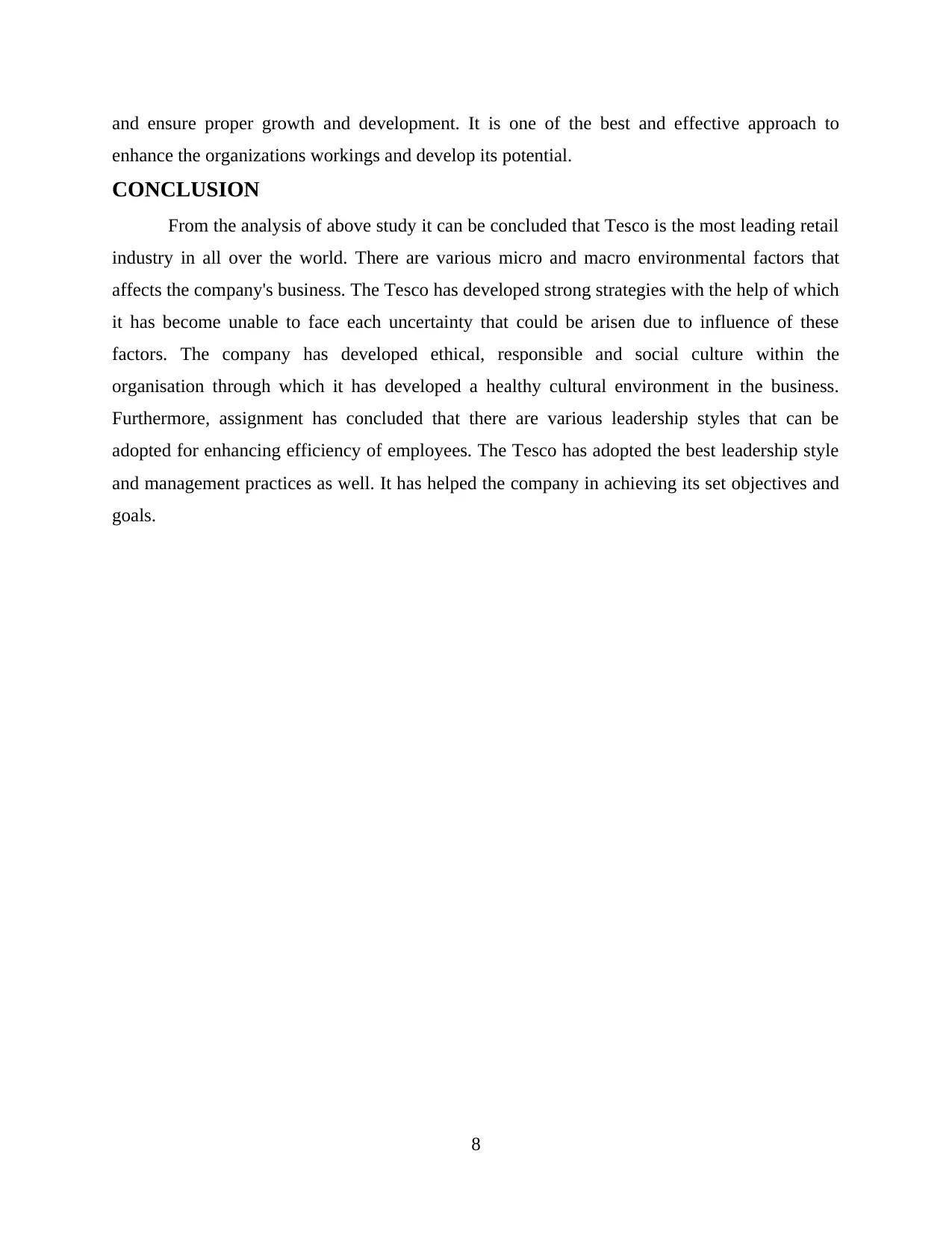
and ensure proper growth and development. It is one of the best and effective approach to
enhance the organizations workings and develop its potential.
CONCLUSION
From the analysis of above study it can be concluded that Tesco is the most leading retail
industry in all over the world. There are various micro and macro environmental factors that
affects the company's business. The Tesco has developed strong strategies with the help of which
it has become unable to face each uncertainty that could be arisen due to influence of these
factors. The company has developed ethical, responsible and social culture within the
organisation through which it has developed a healthy cultural environment in the business.
Furthermore, assignment has concluded that there are various leadership styles that can be
adopted for enhancing efficiency of employees. The Tesco has adopted the best leadership style
and management practices as well. It has helped the company in achieving its set objectives and
goals.
8
enhance the organizations workings and develop its potential.
CONCLUSION
From the analysis of above study it can be concluded that Tesco is the most leading retail
industry in all over the world. There are various micro and macro environmental factors that
affects the company's business. The Tesco has developed strong strategies with the help of which
it has become unable to face each uncertainty that could be arisen due to influence of these
factors. The company has developed ethical, responsible and social culture within the
organisation through which it has developed a healthy cultural environment in the business.
Furthermore, assignment has concluded that there are various leadership styles that can be
adopted for enhancing efficiency of employees. The Tesco has adopted the best leadership style
and management practices as well. It has helped the company in achieving its set objectives and
goals.
8
Paraphrase This Document
Need a fresh take? Get an instant paraphrase of this document with our AI Paraphraser
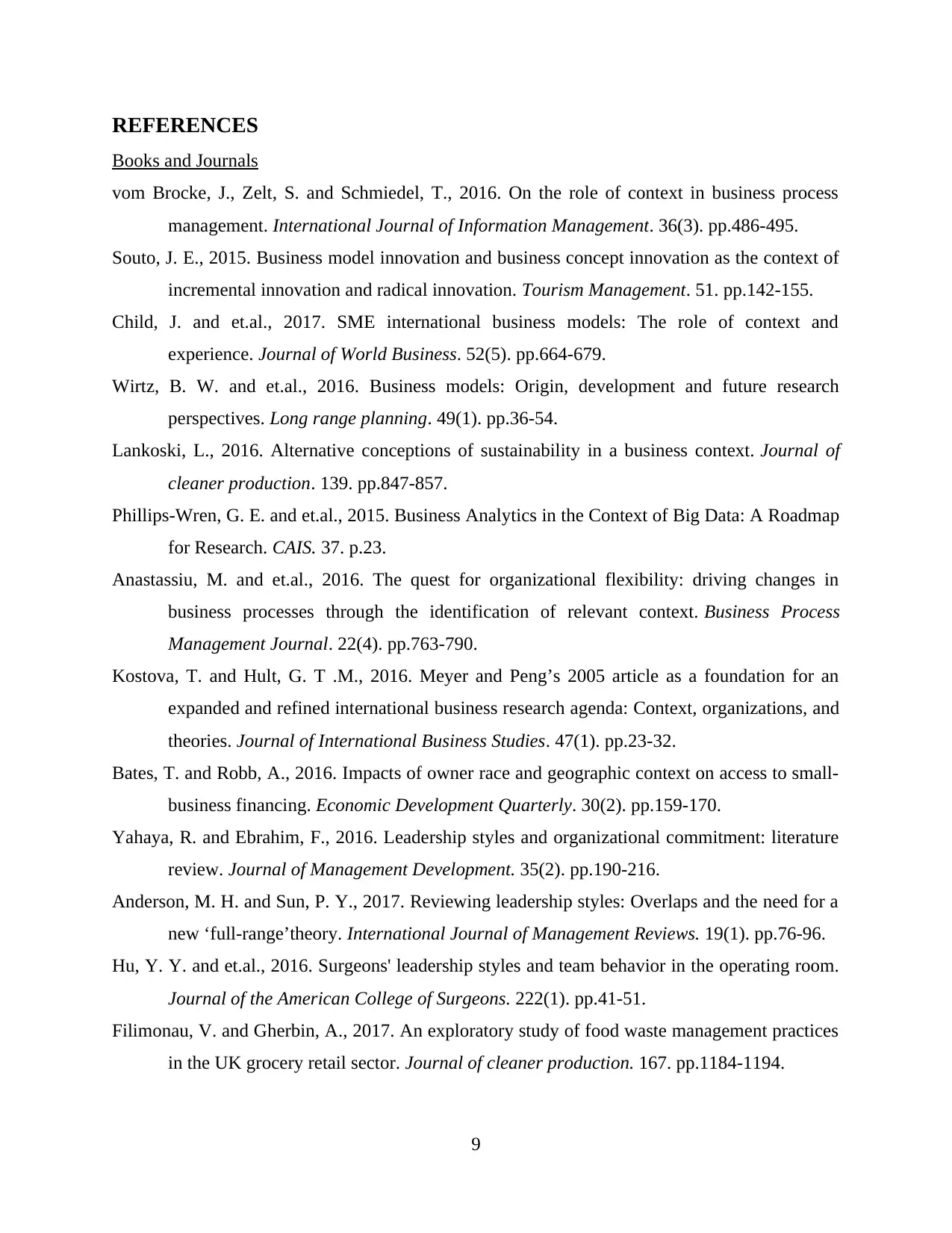
REFERENCES
Books and Journals
vom Brocke, J., Zelt, S. and Schmiedel, T., 2016. On the role of context in business process
management. International Journal of Information Management. 36(3). pp.486-495.
Souto, J. E., 2015. Business model innovation and business concept innovation as the context of
incremental innovation and radical innovation. Tourism Management. 51. pp.142-155.
Child, J. and et.al., 2017. SME international business models: The role of context and
experience. Journal of World Business. 52(5). pp.664-679.
Wirtz, B. W. and et.al., 2016. Business models: Origin, development and future research
perspectives. Long range planning. 49(1). pp.36-54.
Lankoski, L., 2016. Alternative conceptions of sustainability in a business context. Journal of
cleaner production. 139. pp.847-857.
Phillips-Wren, G. E. and et.al., 2015. Business Analytics in the Context of Big Data: A Roadmap
for Research. CAIS. 37. p.23.
Anastassiu, M. and et.al., 2016. The quest for organizational flexibility: driving changes in
business processes through the identification of relevant context. Business Process
Management Journal. 22(4). pp.763-790.
Kostova, T. and Hult, G. T .M., 2016. Meyer and Peng’s 2005 article as a foundation for an
expanded and refined international business research agenda: Context, organizations, and
theories. Journal of International Business Studies. 47(1). pp.23-32.
Bates, T. and Robb, A., 2016. Impacts of owner race and geographic context on access to small-
business financing. Economic Development Quarterly. 30(2). pp.159-170.
Yahaya, R. and Ebrahim, F., 2016. Leadership styles and organizational commitment: literature
review. Journal of Management Development. 35(2). pp.190-216.
Anderson, M. H. and Sun, P. Y., 2017. Reviewing leadership styles: Overlaps and the need for a
new ‘full‐range’theory. International Journal of Management Reviews. 19(1). pp.76-96.
Hu, Y. Y. and et.al., 2016. Surgeons' leadership styles and team behavior in the operating room.
Journal of the American College of Surgeons. 222(1). pp.41-51.
Filimonau, V. and Gherbin, A., 2017. An exploratory study of food waste management practices
in the UK grocery retail sector. Journal of cleaner production. 167. pp.1184-1194.
9
Books and Journals
vom Brocke, J., Zelt, S. and Schmiedel, T., 2016. On the role of context in business process
management. International Journal of Information Management. 36(3). pp.486-495.
Souto, J. E., 2015. Business model innovation and business concept innovation as the context of
incremental innovation and radical innovation. Tourism Management. 51. pp.142-155.
Child, J. and et.al., 2017. SME international business models: The role of context and
experience. Journal of World Business. 52(5). pp.664-679.
Wirtz, B. W. and et.al., 2016. Business models: Origin, development and future research
perspectives. Long range planning. 49(1). pp.36-54.
Lankoski, L., 2016. Alternative conceptions of sustainability in a business context. Journal of
cleaner production. 139. pp.847-857.
Phillips-Wren, G. E. and et.al., 2015. Business Analytics in the Context of Big Data: A Roadmap
for Research. CAIS. 37. p.23.
Anastassiu, M. and et.al., 2016. The quest for organizational flexibility: driving changes in
business processes through the identification of relevant context. Business Process
Management Journal. 22(4). pp.763-790.
Kostova, T. and Hult, G. T .M., 2016. Meyer and Peng’s 2005 article as a foundation for an
expanded and refined international business research agenda: Context, organizations, and
theories. Journal of International Business Studies. 47(1). pp.23-32.
Bates, T. and Robb, A., 2016. Impacts of owner race and geographic context on access to small-
business financing. Economic Development Quarterly. 30(2). pp.159-170.
Yahaya, R. and Ebrahim, F., 2016. Leadership styles and organizational commitment: literature
review. Journal of Management Development. 35(2). pp.190-216.
Anderson, M. H. and Sun, P. Y., 2017. Reviewing leadership styles: Overlaps and the need for a
new ‘full‐range’theory. International Journal of Management Reviews. 19(1). pp.76-96.
Hu, Y. Y. and et.al., 2016. Surgeons' leadership styles and team behavior in the operating room.
Journal of the American College of Surgeons. 222(1). pp.41-51.
Filimonau, V. and Gherbin, A., 2017. An exploratory study of food waste management practices
in the UK grocery retail sector. Journal of cleaner production. 167. pp.1184-1194.
9
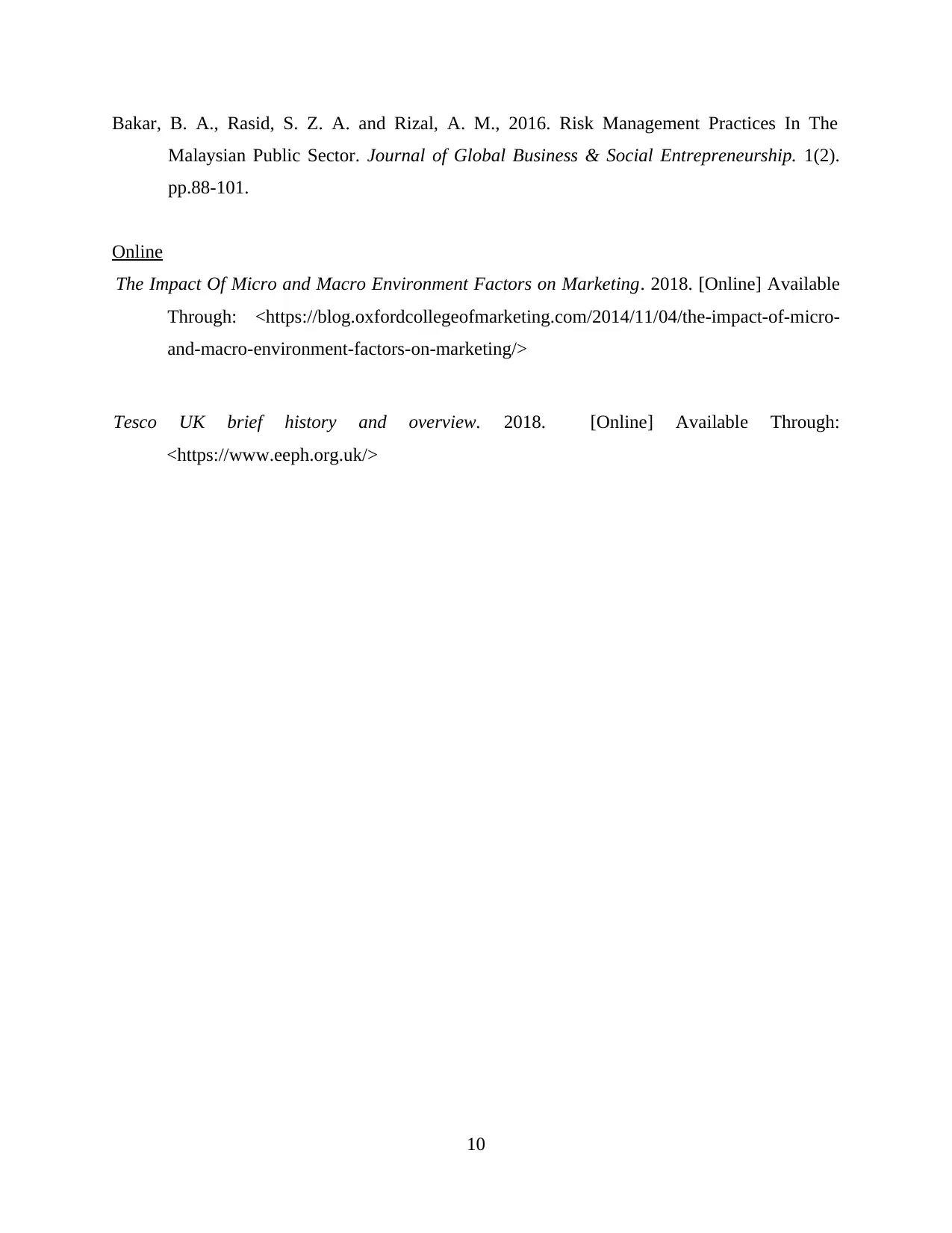
Bakar, B. A., Rasid, S. Z. A. and Rizal, A. M., 2016. Risk Management Practices In The
Malaysian Public Sector. Journal of Global Business & Social Entrepreneurship. 1(2).
pp.88-101.
Online
The Impact Of Micro and Macro Environment Factors on Marketing. 2018. [Online] Available
Through: <https://blog.oxfordcollegeofmarketing.com/2014/11/04/the-impact-of-micro-
and-macro-environment-factors-on-marketing/>
Tesco UK brief history and overview. 2018. [Online] Available Through:
<https://www.eeph.org.uk/>
10
Malaysian Public Sector. Journal of Global Business & Social Entrepreneurship. 1(2).
pp.88-101.
Online
The Impact Of Micro and Macro Environment Factors on Marketing. 2018. [Online] Available
Through: <https://blog.oxfordcollegeofmarketing.com/2014/11/04/the-impact-of-micro-
and-macro-environment-factors-on-marketing/>
Tesco UK brief history and overview. 2018. [Online] Available Through:
<https://www.eeph.org.uk/>
10
⊘ This is a preview!⊘
Do you want full access?
Subscribe today to unlock all pages.

Trusted by 1+ million students worldwide
1 out of 12